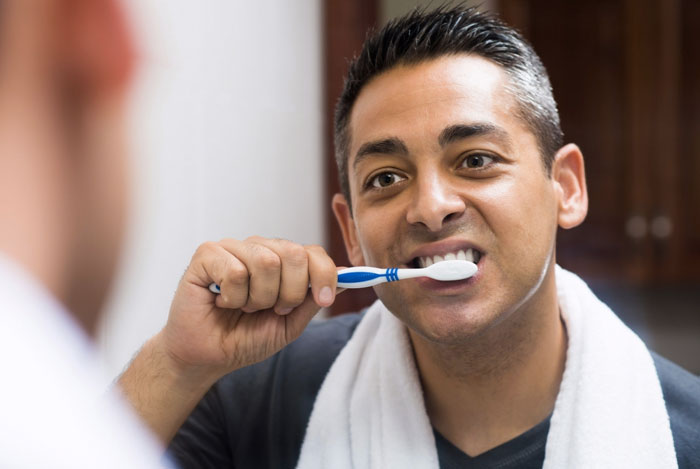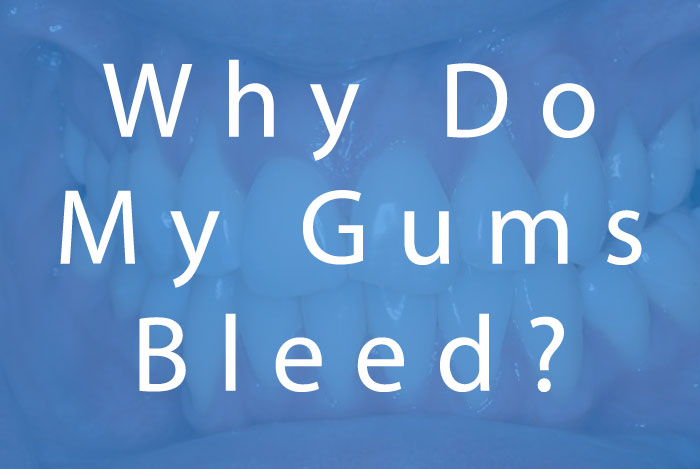Bleeding gums is a sign that you are not brushing your teeth correctly. When we eat, food is pushed between our teeth and gums. If the food is small enough that you do not feel anything, it is usually ignored. Brushing and flossing correctly is intended to remove food from between the teeth. However, brushing or flossing incorrectly (or worse not at all) does not remove everything. That is where the problem starts.
You mouth is a wet, warm place that is perfect for breaking down food into bacteria and acids. Bacteria and acid are the causes of tooth decay and gum disease (also known as periodontal disease). An early sign of gum disease is bleeding gums.
What can I do about it?
In many cases, Bleeding Gums can be addressed simply by getting a cleaning and maintaining proper oral health by flossing and brushing regularly. When you come to the dentist we can tell if you are at risk for gum disease by taking measurements of your gums and testing for bone loss. We can also see in the x-rays if their is a lot of buildup in between and underneath your gums.
These signs are indicative of periodontal disease, in which case you are having bone loss and may need a deep cleaning.
Deep Cleaning vs Regular Cleaning
A regular cleaning is intended to maintain a healthy mouth. Everyone should get a regular cleaning every six months.
A deep cleaning is used to remove harmful buildup from the mouth that has the potential to destroy bone and lead to tooth loss. During a deep cleaning we get you numb and go a little bit deeper underneath your gums to get all of that buildup.
Buildup is hardened plaque that adheres to the tooth underneath the gums. Once it hardens on the tooth it becomes almost impossible for you to remove it yourself at home by brushing and flossing. This buildup needs to be removed mechanically at the dental office.
Can I remove buildup at home?

Brushing and flossing is mainly for maintenance between dental cleanings. So when the plaque hardens it really must be removed professionally via a deep cleaning.
The first thing we do is take measurements to know how deep we need to go in each pocket. Next step would be to get you numb in those areas so that you are not uncomfortable during the cleaning. Then we usually section off the mouth and we do 2 quadrants of the mouth at a time. We usually chose to do one side of the mouth first and have you return for the other side so that you are not numb all around at once.
We take our time, remove all the buildup, and double check to verify that all the buildup has been removed. Many times it is hard to see with the naked eye so we have to verify with our instruments. There are times that we even need to check with an x-ray to make sure all the buildup has been removed.
What happens after the deep cleaning?
Once the deep cleaning is done we will put the patient on a more regular maintenance schedule where we will ask to see the patient every 3 or 4 months for a while instead of every 6 months. It is also very important for you to keep up with the flossing and also the brushing during this time.
The goal is to minimize the amount of buildup that is occurring in between the teeth and underneath the gums. Once their is bone loss that has occurred also known as periodontal disease, it is really hard to get that bone back and many times it is impossible. The goal of periodontal treatment weather it is just a deep cleaning or something more is to stop the bone loss and make sure you have a good base for your teeth.
Many patients find flossing to be very difficult, time consuming, and uncomfortable. That may be the case at first but as you floss regularly your gums will get stronger due to the constant stimulation. This helps a great deal with periodontal disease and your gums bleeding.
It may be the first couple times you floss your gums will feel a little inflamed and have some bleeding but as you continue your gums will continue to get stronger and the pain will decrease significantly.
An ounce of prevention…

Bleeding gums is a regular complaint that we hear at our office from our patients. However with regular dental exams, a good cleaning, followups, and your at home brushing & flossing, it is something that can be easily controlled and maintained.

